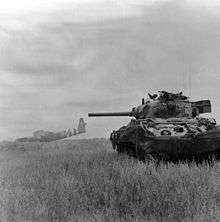Lend-Lease Sherman tanks
| Medium Tank M4A2 Sherman III | |
|---|---|
|
Medium Tank M4A2 Sherman III. Most of these, the only large-production diesel variant, were Lend-Leased to the Allies | |
| Place of origin | United States |
| Specifications | |
| Weight | 29.94 tonnes (66,000 lbs empty (late production)) |
| Length | 5.92 m (19.42 ft) |
| Width | 2.62 m (8.6 ft) |
| Height | 2.74 m (8.99 ft) |
| Crew | 5 |
|
| |
| Armor | 13 - 108 mm (0.5 - 4.25 in) (late production) |
Main armament |
75 mm M3 L/40 Gun 97 rounds |
Secondary armament |
.50 Browning M2HB machinegun 300 rounds 2× .30-06 Browning M1919A4 machineguns 4,750 rounds |
| Engine |
General Motors 6046 diesel (conjoined twin 6-71s) 410 hp gross @ 2900 rpm 375 hp net (280 kW) @ 2100 rpm |
| Power/weight | 12.89 hp/tonne |
| Suspension | Vertical Volute Spring Suspension (VVSS) |
| Speed | 48 km/h (30 mi/h) brief level |
The United States provided tens of thousands of its Medium Tank M4, also named the Sherman, to many of its Allies during the Second World War, under the terms of Lend-Lease.
British nomenclature
The British received far more M4 medium tanks, approximately 17,000 (roughly 34% of all M4s produced), than any other Allied nation. The British practice of naming American tanks after American Civil War generals was continued, giving it the name General Sherman after Union General William Tecumseh Sherman, usually shortened to Sherman. The US later adopted the name and the practice of naming tanks after generals.
In the British naming system the major variants were identified by Mark numbers, the M4 being "Sherman I", the M4A1 "Sherman II" and so on. Letters after the mark number denoted modifications to the base model: "A" for the 76 mm L/55 gun instead of the 75mm, "B" for the 105 mm M4 L/22.5 howitzer, "C" for the (British) QF 17 pounder (76.2 mm) gun, and "Y" for the later wider-tracked Horizontal Volute Spring Suspension (HVSS) type suspension. Gun and suspension letters were used in combination, e.g. Sherman IBY. However, no production 75mm Shermans were built with HVSS and no HVSS Firefly conversions (CY) therefore existed. HVSS Shermans were only fitted with 76mm M1 guns or 105mm M4 howitzers, AY and BY respectively in British service.
- Sherman I - M4 with 75 mm M3 L/40 gun and Continental R975 9-cylinder radial petrol engine
- Sherman Hybrid I - Sherman I with composite hull (cast front, welded rear)
- Sherman IB - Sherman I with 105 mm M4 L/22.5 howitzer
- Sherman IBY - Sherman IB with HVSS
- Sherman II - M4A1 with 75 mm M3 L/40 gun and Continental R975 radial petrol engine
- Sherman III - M4A2 with 75 mm M3 L/40 gun and GM6046 twin 6-cylinder diesel engine
- Sherman IV - M4A3 with 75 mm M3 L/40 gun (no Sherman IVs used operationally) and Ford GAA V8 petrol engine
- Sherman V - M4A4 with 75 mm M3 L/40 gun and Chrysler A57 multibank 30-cylinder "cloverleaf" petrol engine in a longer rear hull with more widely spaced bogies
- Sherman VI - M4A5 (paper designation for Canadian production)
- Sherman VII - M4A6 with 75 mm M3 L/40 gun, composite cast/welded hull and Ordnance RD-1820 9-cylinder radial diesel engine. Only 75 M4A6 were built and none are believed to have reached the UK
- Sherman II ARV III - M32B1 TRV (M4A1 Sherman II chassis) recovery vehicle
- Sherman V ARV III - M32B4 TRV (M4A4 Sherman V chassis) recovery vehicle. Extremely rare, almost mythical, vehicle. Production records are sketchy and British use is uncertain, but a photo does exist of an M32B4 in post-war Greek service
Allied variants
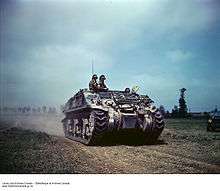
Conversions and modifications of the M4 by their foreign users included the British-Commonwealth Firefly with potent British QF 17 pounder (76.2 mm) anti-tank gun; Adder, Salamander, Crocodile, and Badger[1] flame-throwing Shermans; Kangaroo armoured personnel carrier; Armoured recovery vehicles (ARV); artillery tractors, and the specialist military engineering vehicles of "Hobart's Funnies" designed specifically for Operation Overlord ("D-Day") and the Battle of Normandy. In 1945, the 1st Coldstream Guards at the Rhine fitted Sherman turrets with two "60 lb" RP-3 air-to-ground rockets on rails to create the Sherman Tulip. Canada created a prototype anti-aircraft vehicle with four 20 mm Polsten cannons mounted in a turret on Canadian-made M4A1 hull which was called Skink. The Soviets reportedly replaced the US 75 mm gun on some M4A2s with the 76.2mm F-34 gun of the T-34 medium tank to create the M4M but discontinued the practice when assured of US ammunition supply (Zaloga 1984:217). For the D-Day landings the British developed special and specific deep wading kits for Shermans I/II, III and V. US forces in the Pacific suffered many drowned M4s by not having such kits early in the island landing campaigns, and they were rapidly copied for later landings.
Armament conversions

A number of Sherman tanks were converted to carry different armament other than that with which the tank was originally manufactured. Among these were:
- Tank AA, 20 mm Quad, Skink - Canadian prototype anti-aircraft vehicle with four 20 mm Polsten cannon mounted in a turret on a Grizzly hull (tank made in Canada, not Lend-Leased).[2]
- Sherman Duplex Drive (DD) - British-developed swimming gear fitted to British, Canadian, and US Shermans for the Normandy landings.
- Sherman Firefly - British Sherman I or V re-armed with QF 17 pounder (76.2 mm) anti-tank gun with C added to designation (as in Sherman IC or VC). A few Sherman IIIC are believed to have existed, issued to units equipped with standard Sherman III for mechanical commonality: Aberdeen Proving Ground in the USA has one.
- Sherman Tulip - British Sherman with two 3-inch ("60lb") RP-3 rockets on rails added to the turret. Used by the 1st Coldstream Guards at the Rhine in 1945.
- M4M — Soviet M4A2s reportedly converted to 76.2mm F-34 gun, as mounted in the T-34. There was no shortage of U.S. 75 mm ammunition, however, so there was little need to continue converting Shermans. (Zaloga 1984:217).
- RMASG Control Tank — While not strictly an armament conversion, as no new ordnance was involved, Sherman V tanks allocated to the Royal Marines Armoured Support Group for the D-Day landings were fitted with a dial sight in a protruding square cover on the top right of the turret. This permitted them to be used accurately in the indirect fire role as self-propelled artillery, initially from the decks of landing craft but later also ashore. Direct fire sights were retained. These tanks can be identified in photos by the 360 degree compass bearing markings around the turret.
Combat engineering vehicles
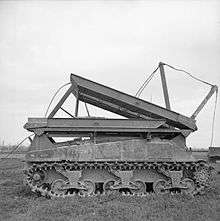
British developments for Shermans were extensive and included the fascine carrier (used by 79th Armoured Division), "Crib", "Twaby Ark", "Octopus",
- Sherman Bridgelayer -
- "Plymouth" - carrying Bailey Bridge
- Sherman AVRE with Small Box Girder bridge
- Sherman CIRD - fitted with "Canadian Indestructible Roller Device" landmine exploder
- Sherman Crab - British Sherman with mine flail, one of a long line of flail devices
Recovery vehicles
- Sherman ARV I and Sherman ARV II - British armoured recovery vehicle conversions of Sherman I, III and V. It was British policy to have ARVs using the same mechanical parts as the gun tanks they supported wherever possible. ARV I was a simple turretless towing vehicle with light jib while ARV II had much more sophisticated recovery and repair equipment, a raised box-like superstructure and heavier jib. It was considered superior to the US M32 ARV, very few of which were used by British units.
- Beach Armoured Recovery Vehicle (BARV) - British conversion of Sherman III with large boat-shaped superstructure that was capable of deep wading near the shore. A simple push/pull ARV that served until replaced by Centurion BARV in the mid-1960s. The diesel-engined Sherman III was considered less likely to be affected by the wet environment than petrol-engined versions.
Artillery
- Sherman Gun Tower - British field conversion in Italy by removing turrets from M4A2 Sherman III tanks to tow 17 pdr AT gun and carry crew with ammunition. Some of the removed 75mm M3 guns may have been used for the Churchill NA75 field conversions unique to the Italian campaign.
- Sherman Observation Post - an armoured mobile post for controlling artillery. The 75 mm gun was removed (with a dummy barrel fitted outside) to give room for map tables in the turret. Three radio sets were fitted (two Number 19 and a Number 18). Two more - both Number 38 - were carried for portable use outside the tank.[3]
Personnel carriers
- Sherman Kangaroo - Canadian Sherman converted into Kangaroo armoured personnel carrier
Flame Tanks
- Sherman Adder - A conversion kit to equip Sherman tanks, used in India on Sherman III and Sherman V
- Sherman Badger - Canada's replacement of its Ram Badger, the Sherman Badger was a turretless M4A2 HVSS Sherman with Wasp IIC flamethrower in place of hull machine gun, developed sometime from 1945 to 1949. The 150 gallons at 250 psi was effective to 125 yards, with elevation of +30 to -10 degrees and traverse of 30 degrees left and 23 degrees right. This inspired the US T68.[4]
Service history
Britain
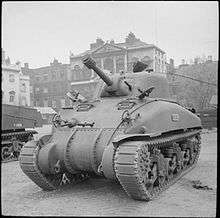
The British Empire received 17,184 Sherman tanks under Lend-Lease, roughly 78% of all Shermans provided worldwide under this program. This includes Sherman tanks used by all members of the British Empire. The first few Sherman IIs received by the UK were equipped with two driver-operated fixed machine guns in the hull and the shorter M2 75mm gun with a counterweight. This was a standard feature of very early Shermans carried over from the M3 Medium tank and was one of the first things to be dropped from the design. Bovington Tank Museum has an example of this build standard, named "Michael". The British became the primary users of the M4A4 Sherman V, which they found to be far more reliable than did the few US users. M4 Sherman I, M4A1 Sherman II and M4A2 Sherman III were also used in roughly that order of importance. Free Polish and Czech armoured units supported and equipped by the British had mostly M4A2 with some M4A4.
Some Shermans in British service were converted to specialist combat engineering vehicles primarily for the invasion of France. The Sherman Crab was the main conversion, used to clear minefields in North West Europe and Italy. The Beach Armoured Recovery Vehicle was a waterproof Armoured Recovery Vehicle produced in small numbers and used only in support of beach landings to pull drowned vehicles from the water and to push off stuck beached landing craft.
North Africa
The first Shermans to see battle were M4A1s with the British Eighth Army at the Second Battle of El Alamein in October 1942. The tanks had been supplied in a hurry from the US which had removed them from their own units. They were then modified to British requirements and for desert conditions.[5] Over 250, in 12 regiments, started the battle. They formed the "heavy squadrons" (16 tanks in each) of one brigade in each division of X Corps and some other squadrons of the other units taking part; the other heavy squadrons were still equipped with Grants and light squadrons were equipped with 'Honey' Stuart and Crusader tanks. The Shermans were still "outclassed" by the long gunned Panzer IV "Specials", but the British still carried the battle. The Sherman units were not involved to a great extent in the subsequent pursuit of the German tanks. The Sherman was able to tackle enemy rearguard units by using HE fired indirectly whilst the German 5 cm Pak 38 anti-tank gun was only effective against the Sherman if it could engage it from the sides. More of the units in North Africa were converted to Shermans, including Sherman III though the infantry tank units retained their Churchills.
Italy
The British in Italy did not use cruiser tanks; in their place, they used Shermans and turretless Stuart tanks (Stuarts equipped the reconnaissance troops). The other tank of the campaign was the - mainly 6 pdr equipped - Churchill tank; those units were bolstered with Shermans. In general, the Shermans were acting in the infantry support role in difficult terrain against fixed German defences. At the end of 1944, 76 mm and 105 mm gun Shermans and 17 pdr Fireflies started to be used by the British as they came up against the Gothic Line.
Northwest Europe
British and Commonwealth use in Europe was comprehensive. The Sherman replaced the General Grant, General Lee and the Ram Tank in Canadian service and was in the majority by 1944 - the other main late-war tanks being the Churchill and Cromwell. The Cromwell was used in reconnaissance because of its superior speed and the Churchill had better cross country mobility.
The Sherman Firefly variant was converted mostly from the M4 Sherman I and M4A4 Sherman V, with possibly a few Sherman III, and was used both in Sherman and Cromwell-equipped units to add extra anti-tank capability even though the Sherman was noticeably slower than the swift Cromwells. The Firefly was necessary as the intended supplement (the 17 pdr development of the Cromwell was produced in insufficient numbers whilst the production of the Firefly was much greater). A 1944-pattern British armoured squadron (equivalent to a US company) had one Firefly per troop (platoon) of 4 Shermans. Later, when the Sherman was being replaced in some British units by the Cromwell, the Firefly was retained in Cromwell units until the introduction of the Comet which carried the 77mm HV, a shortened derivative of the OQF 17 pounder firing the 17 pounder shell from the cartridge of the obsolete 3" 20cwt AA gun for less recoil but with slightly less armour penetration.
By the end of the war, 50% of the Shermans in British service were Fireflies. With the end of the war and with superior tanks entering service, the UK returned its Shermans to reduce its Lend-Lease payments. However, the US did not really want the Firefly conversions returned and many found their way from British stocks into other armies post-war, where they served until the 1960s in many cases (e.g. Argentine Repotenciado upgrade of IC and VC fitted with French 105mm gun and diesel engine).
India
In the Indian Army tradition, formations included British regiments alongside Indian Army units.[nb 1] As well as some Indian units receiving Shermans, the 116th Regiment Royal Armoured Corps (converted from the 9th Battalion Gordon Highlanders) part of 255th Brigade was equipped with Shermans. As part of the 255th, they were involved in January and February 1945 in Burma in action near Meiktila and Mandalay. The actions were predominantly in support of infantry with few enemy tanks encountered.[6] After that, they were part of mobile columns that moved to retake Rangoon.
New Zealand
The 4th New Zealand Armoured Brigade operated approximately 150 M4A2 Sherman tanks from late 1942 until the end of the war. The 4th Brigade formed part of the New Zealand 2nd Division and was converted from an infantry brigade. The 4th Armoured Brigade saw action during the Italian Campaign.[7]
Australia
.jpg)
Although the Australian Army received 757 M3 Lee/Grants in 1942, it only received three Sherman tanks. These three tanks were supplied by the UK and were only used for trials purposes. When the Australian Cruiser tank programme was cancelled in 1943, a proposal was made to replace the entire order of 775 Australian Cruiser tanks with 310 Sherman tanks; however, this proposal was not acted on.
Australia's first Sherman, an M4A2, arrived in Australia in 1943 with a further two M4s (sometimes mis-labeled as M4A1s) arriving for tropical trials in New Guinea in 1944. The results of these trials showed that the British Churchill tank was better suited to jungle warfare's low-speed infantry support than the Sherman. As a result, the Australian Government ordered 510 Churchills, of which 51 were delivered before the order was cancelled at the end of the war, and did not order any further Shermans. Following the war, the three trials tanks were placed on display at Australian Army bases and one was later destroyed after being used as a tank target.[8]
Canada
The United States officially did not list Canada as a Lend-Lease recipient, but did create the 1941 Joint Defense Production Committee with Canada so that "each country should provide the other with the defense articles which it is best able to produce" and American Locomotive Company enabled its Canadian subsidiary, the Montreal Locomotive Works, to build M4A1 variants in Canada. Canada received four Shermans under Lend-Lease; the mechanism of this is not fully understood.[9] The MLW built 188 Shermans called the Grizzly I cruiser in Canadian service, which were restricted to training. MLW investment in Sherman production was turned to production of the Sexton self-propelled gun. In European combat, the Canadian Army used American-built Shermans supplied by the UK. These were armed with 75 mm, 105 mm and 17-pounder guns.[10]
China
An estimated 812 Shermans were transferred to China under Lend-Lease.[11] Chinese forces in India received 100 M4A4 Shermans and used them to great effect in the subsequent 1943 and 1944 offensives in Battle of Northern Burma and Western Yunnan. After the war, the M4A4s were used during the Huaihai Campaign.
USSR
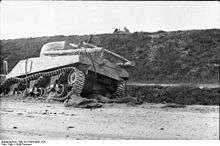
The Soviet Union's nickname for the M4 medium tank was Emcha because the open-topped figure 4 resembled the Cyrillic letter che or cha (Ч). The M4A2s used by the Red Army were considered to be much less prone to blow up due to ammunition detonation than the T-34 (T-34-76), but tended to overturn in road collisions because of its much higher center of gravity.[12]
A total of 4,102 M4A2 medium tanks were sent to the U.S.S.R. under Lend-Lease. Of these, 2,007 were equipped with the 75 mm gun, and 2,095 carried the 76 mm gun. The total number of Sherman tanks sent to the U.S.S.R. under Lend-Lease represented 18.6% of all Lend-Lease Shermans.[13]
The first 76-mm-armed Shermans started to arrive in Soviet Union in late summer of 1944.[14] In 1945, some units were standardized to depend mostly on them, and not on the ubiquitous T-34: 1st Guards Mechanized Corps, 3rd Guards Mechanized Corps, and 9th Guards Mechanized Corps.[14]
Poland
Poland was not a recipient of Lend-Lease aid directly from the United States, however, Polish forces also used a wide variety of Shermans redirected from Lend-Lease shipments to the British Empire. The Polish 1st Armoured Division entered the Battle of Normandy mostly equipped with Sherman Vs (M4A4s) with 75 mm guns, and Firefly VC Shermans, and some Cromwells.[nb 2] After heavy losses closing the Falaise Pocket and Dutch campaign, the division was re-equipped, largely with Sherman IIA (M4A1 (W) 76 mm) models. Many of the tanks had their entire glacis plate and turret front covered by spare track links in an attempt to improve the tank's protection.
The Polish II Corps, fighting in Italy, primarily used M4A2s (Sherman III) that had been used by the British Army in Africa. However, some Firefly ICs and Sherman IB (M4(105 mm)) howitzer tanks were also used.
Parts of the Polish First Army also briefly used M4A2 (76 mm) borrowed from the Soviet armies after heavy losses in the conquest of Danzig. After receiving replacements, the army was re-equipped with T-34s.
France

Free French Forces used several versions of the M4 medium tank. Tanks were provided by the U.S. under Lend-Lease. French armored divisions were organized and equipped the same as U.S. Army, light armored divisions. In 1943, the French decided to create their new army in north Africa, and had an agreement with the Americans to be equipped with modern US weapons. The French 2nd Armored Division (French: Division Blindée, DB) entered the Battle of Normandy fully equipped with M4A2s. The 1st and 5th DB, which entered southern France as part of the First French Army, were equipped with a mixture of M4A2 and M4A4 medium tanks. The 3rd DB, which served as a training and reserve organization for the three operational armored divisions, was equipped with roughly 200 medium and light tanks. Of these, 120 were later turned in to the U.S. Army's Delta Base Section for reissue. Subsequent combat losses for the 1st, 2nd, and 5th Armored Divisions were replaced with standard issue tanks from U.S. Army stocks.[15]
Brazil
Brazil received 53 Sherman tanks under Lend-Lease in 1941, all equipped with the 75 mm gun. These tanks were not used by the Brazilian Expeditionary Force in Italy during the war, but sent directly to defend Brazil itself. In the early 1950s, another group of 30 Sherman tanks was delivered under the Military Assistance Program, bringing the total number of Shermans to 83 tanks. The variants of these tanks consisted of 40 M4, 38 M4 with the Composite Hull, and 2 M4A1. The Brazilian Army used the Shermans until 1979 when they were replaced by M41 tanks.[16]
Czechoslovakia
While the Czechoslovak government-in-exile did not receive Lend-lease equipment from the United States, its 1st Czechoslovak Armoured Brigade was equipped and supplied by the British Army. The Brigade's equipment during the siege of Dunkirk included 36 Sherman Firefly ICs in addition to Cromwell tanks, which constituted the primary armoured vehicle operated by the brigade. The Fireflies were, in May 1945, exchanged for 22 Challengers with which the brigade returned home. In addition, one damaged Sherman I abandoned by an unknown unit was salvaged from the battlefield by the brigade's repair shop and was later used as a recovery vehicle. This vehicle returned with the brigade to Czechoslovakia.[17]
South Africa
South Africa had a few Sherman Firefly's. These were used by the 6th Armoured Division.
Combat performance

The best anti-tank gun on a World War II combat Sherman was the British QF 17 pounder (76.2 mm) gun, a very high-velocity weapon firing APDS shells capable of defeating the heavier German tanks. The 17 pounder had already shown its value in 1943, in Africa as a towed anti-tank gun. It proved an effective weapon against German tanks. With the APDS developed for the 17 pounder, the Firefly's performance was increased again. Although the 17-pounder was an excellent anti-armor weapon, initially the HE shell provided was weak, making it a poor general-purpose tank gun. However, the HE shell problem was later resolved.
See also
- Postwar Sherman tanks
- Hobart's Funnies
- 79th Armoured Division
- Allied technological cooperation during World War II
Endnotes
- Notes
- ↑ The Army of India consisted of both the Indian Army and the British Army in India between 1903 and 1947.
- ↑ With the 10th Mounted Rifle Regiment.
- Citations
- ↑ R. P. Hunnicutt, Sherman: A History of the American Medium Tank, Presidio Press, Novato, CA, 1994, p. 420-421.
- ↑ http://web.archive.org/web/20080108124612/http://www.geocities.com/pentagon/bunker/3351/allweps/skink.html
- ↑ Hunnicutt Sherman: A History of the American Medium Tank p 309
- ↑ R. P. Hunnicutt, Sherman: A History of the American Medium Tank, Presidio Press, Novato, CA, 1994, p. 420-421.
- ↑ Sandars p6
- ↑ Sandars p21
- ↑ A. H. McLintock, ed. (1966). "WARS – SECOND WORLD WAR - The Army". The Encyclopedia of New Zealand.
- ↑ Paul D. Handel Australian Shermans Accessed 30 June 2006.
- ↑ "Lend-Lease Shipments: World War II," Section IIIB, Published by Office, Chief of Finance, War Department, 31 December 1946, p. 8.
- ↑ Guthrie, Steve The Sherman in Canadian Service Service Publications, Ottawa, ON. ISBN 1-894581-14-8
- ↑ Hunnicutt p.166
- ↑ Лоза Дмитрий Федорович - Я Помню. Герои Великой Отечественной войны. Участники ВОВ. in Russian.
- ↑ Lend-Lease Shipments: World War II, Section IIIB, Published by Office, Chief of Finance, War Department, 31 December 1946, p. 8.
- 1 2 Zaloga, Steven (2003-04-20). M4 (76mm) Sherman Medium Tank 1943-65. p. 37. ISBN 9781841765426.
- ↑ (Vigneras, Marcel, "Rearming the French," Office of the Chief of Military History, Dept. of the Army, (Washington, DC GPO) 1957, p. 244-246.)
- ↑ M4 Sherman no Brasil ISBN 978-85-99719-07-7
- ↑ Jakl, Tomáš (2006). "Československé Shermany". Historie a plastikové modelářství. HaPM Ltd. XVI (12): 22–23. ISSN 1210-1427.
Sources
- Zaloga, Steven J.; James Grandsen (1984). Soviet Tanks and Combat Vehicles of World War Two. London: Arms and Armour Press. ISBN 0-85368-606-8.
- Sandars, John (1982). The Sherman Tank in British service 1942-1945. Vanguard. Oxford: Osprey Publishing. ISBN 0-85045-361-5.
- Hunnicutt, R. (1978). Sherman. San Rafeal: Taurus Enterprises. ISBN 978-0-89141-080-5.
- http://www.mapleleafup.org/intro.html
- Tanks!
- http://www.junobeach.org/e/4/can-tac-arm-she-e.htm
- http://digital.lib.umn.edu/TEXTS/011/0002BODY.PDF
- "M4 Sherman" (in Danish). ww2photo.mimerswell.com.
External links
| Wikimedia Commons has media related to M4 Sherman. |
- Allies and Lend-Lease Museum, Moscow
- M4 Sherman photogallery 1 at ww2photo.mimerswell.com
- M4 Sherman photogallery 1 at ww2photo.mimerswell.com
